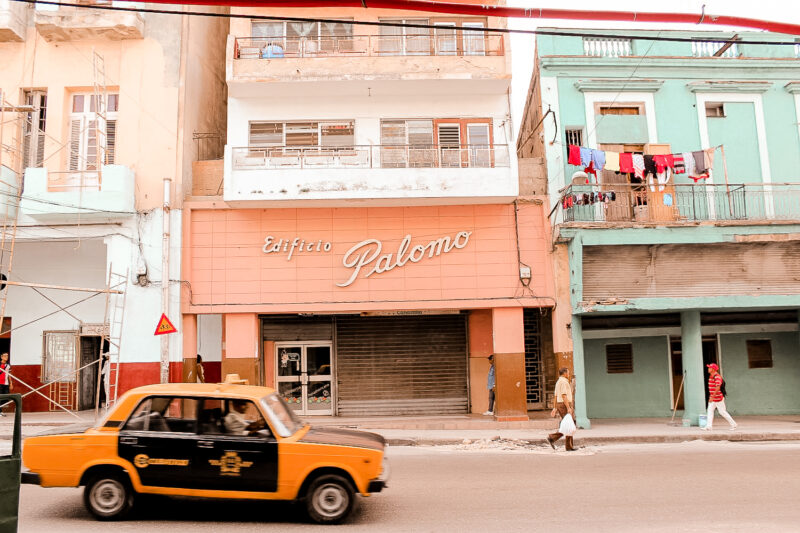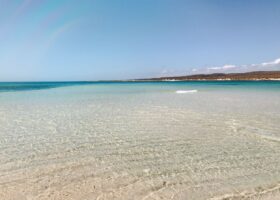
When I think of Cuba, my mind flashes back to the innocent 50s. Vintage cars patrolling the streets, vibrant buildings juxtaposed with crumbling shambles living next door to each other, and joyous natives playing music on their steps while people-watching. Recently, direct flights to Cuba from California opened route, which made my excuses for not going to Cuba ASAP absolutely unsound. Looking forward to mojitos, freshly rolled Cubans, and cruising around town in a vintage Chevy, I packed my sunnies and walking shoes for my inaugural voyage to the Caribbean. For anyone considering a trip to colorful Cuba, I encourage no hesitation in going within the next few years, as its authenticity should be enjoyed now. Here are some tips and information from my perspective, your very own mini Cuban Travel Guide.

What to Book or Do Ahead of Time
Your Visa
US Passport holders: Ahoy! You’ve booked your trip to Cuba and with much excitement, you’re ready to fly! Not quite. If you’re a citizen of the USA, you will need a travel visa. I booked mine ahead of my trip with Cuba Travel Services which is legitimate and has a stand at the airport (we flew out of LAX). Ordering ahead cost me about $110, and it should be slightly cheaper at the airport, sans shipping fees.
Remember, legally Americans cannot visit Cuba for ‘tourism,’ but it must fall under one of these categories as outlined by the U.S. Embassy:
- family visits
- official business of the U.S. government, foreign governments, and certain intergovernmental organizations
- journalistic activity
- professional research and professional meetings
- educational activities (people-to-people)*
- religious activities
- public performances, clinics, workshops, athletic and other competitions, and exhibitions
- support for the Cuban people
- humanitarian projects
- activities of private foundations or research or educational institutes
- exportation, importation, or transmission of information or informational materials
- certain authorized export transactions
*this was our travel reason, and we were not questioned about it at entrance. People often visit for support for Cuban people or journalistic activity as well
Your accommodations and “casa particular”
You can get away with arriving to Cuba and having no place to stay, as you can look for any home with an “Arrendador Divisa” sign and see if they have vacancy. These are casa particulares, or homes that Cubans open up for rent to visitors, which can be read about more here. However, if you want to see the living space you’ll be living in beforehand, you can be more selective by booking on AirBnB before your trip.
Bring and Know the Right Currencies
If you’re American, I highly suggest exchanging your USD to euros or Canadian dollars before your trip. There is an automatic additional 10% surcharge fee on exchanging USDs to CUCs at Cuban exchange places and banks.
Download Maps.Me
This was my key source of navigation and has pinpoints that other travelers save on the map. You can also enter your location, pin your map for where you’re staying, and look up restaurants, banks, WiFi, and anything else you’ll need.
What You Will Need & What to Pack
- Basic Working Spanish
- Comfortable Walking Shoes
- Toilet Paper
- Snack Bars
- Change for Restrooms
You can absolutely find great food in Cuba, though be warned that often “Snack Bars” won’t sell substantial snacks, but rather ice cream, coffee, or soda. Per the suggestion of a couple friends, we packed granola bars, protein bars, pretzels, etc to satisfy our bottomless stomachs for the trip.
What should I pack, and how is the weather?
Before booking, research hurricane season as the Caribbean is tropical and very sensitive to these weather patterns. We were in Cuba at the beginning of February, and the weather was warm but not too hot, with a sprinkle of rain on our last day that eventually turned into a quick downpour. Dresses, skirts, shorts, sandals were appropriate for this trip. With that comes sunglasses, sunscreen, swimsuits, and hats. Pack a jacket for the evenings and bug repellent since this is in Zika zone. If you’ll be exploring Havana by foot, bring comfortable walking shoes.

Food + Drink
- El Floridita daiquiri – the famous Ernest Hemingway favorite*
- La Bodeguita del Medio – known for the mojitos
- El del Frente – fun, modern spot with a roof deck
- Cafe de los Artistas – artistic, hip scene with good dishes and a mixologist
- Cafe Presidente – modern, quick food
For a more thorough list of bars to visit, check here.
Entertainment
- La Zorra y el Cuervo – visit the nightlife and jazz scene of Havana
- Fabrica de Arte Cubano – a truly trendy spot for anyone craving a modern art show, live jazz club, hip coffee spot, social roof deck, and many different art scenes. This is a must, and costs 2 CUC to get in. Try to arrive early to avoid a wait in the line and assure entrance.
- People-watching: on the malecon, or anywhere
Outside Havana
- Playa del Este, Playa Santa Maria: Same strip of beach about 30 minutes outside Havana with palm trees, coconuts sold on the beach, and turquoise blue waters. We were able to ride here for about 15 CUC each way.
- Cienfuegos
- Vinales: Beautiful, lush countryside about a 3 hour drive outside Havana
- Trinidad: about 7-8 hours driving from Havana, friends raved about Trinidad and mentioned a cool underground cave to party in!
- Varadero: about 4 hours outside Havana, with clear blue waters and white sand. A total tourist destination for relaxation, with some areas that are man-made.
Vinales
At about 8 AM, after munching down our guava, starfruit, and fried eggs, we got into a pre-arranged vintage Chevy for a day adventure to Vinales, about 2.5 hours outside of Havana. We chose to go with Hasta Cuba for their amazing accommodation, communication, and pricing that beat out competitors. With a day that topped the trip, we not only go to visit the lush land where Cuban cigars are created, but we got a real snapshot at the Cuban countryside.
Riding along the highway was fairly smooth, and we noticed a lot of old-school horse carriages along the side of the highway being used, from daylight all the way through the pitch black darkness of the night. Men even sold roasted chickens on the side of the freeway, dangling fresh from the stick. On this journey, we stopped at a gas station and saw several feral stray dogs (also within the city too). After getting off the freeway, we encountered many pothole-riddled roads that were poorly filled with rubble, and our native driver knew just where to steer around for caution. We stopped at a historical location with a cave tour, followed by a journey to an authentic Cuban restaurant out of what looked like a home, nestled along the mountains. Our meal was memorable, tasty, and the true experience even with starfruit and fresh squeezed sugar cane made into a cocktail. Afterwards, we went to a tobacco farm to see the real deal, how the tobacco leaves are dried, the process behind perfecting and rolling cigars, and smoking a freshly rolled cuban. We even got to horseback ride through the farm to a little coffee and special rum stand afterward. When we returned, we dipped our cigars in honey and set back on the road!
On the way back, it was amazing to see the Vinales sunset and see that even those horse-drawn carriages were running through the darkest of the night, no street lights. On this day we also noticed that random police checks were not uncommon to check for taxi papers. This was by far my favorite adventure day in Cuba!
Heard It Through the Grapevine
Fun facts we heard from other travelers, residents, or through word of mouth:
- Cubans make an average of 20-40 CUC a month from the government. Some try to make more by opening their houses as casa particulares, or if you have someone approach you on the street “recommending a restaurant,” they are likely making commission for sending you there
- The Cuban government allots each family oil, rice, beans, the basics for each month. It’s extremely tough for those with special health needs, like gluten-free requirements
- We noticed options were at a bare minimum. Perusing the streets and markets, there was usually one brand and one option for anything. One brand of tampons, one style of a bra, one type of oil, one brand or style of pasta
- Yellow taxis have a set fare and are usually more expensive than a vintage taxi, which has more flexibility in pricing and should be cheaper to negotiate
- Fake cigars are sold to people, be careful about buying them off individuals on the street or out of a formal setting. Cigar clubs are best for authentic cigars
- Mojitos are not actually made with mint! Classic mojitos are made with hierbabuena, a plant unavailable in most other parts of the world
Other Questions
Where can I get WiFi?
ETECSA – these open around 8 AM until 6 PM, but often they sell out of WiFi cards early anyway. WiFi cards should cost 2 or 3 CUC, but you can buy them on the street off someone for 5 CUC. Then, you need to find a designated WiFi spot (like a government-approved hotel) to connect. Before we left, we downloaded Maps.Me and had the Havana maps saved to our phones. This was a total lifesaver, as the map can direct you to ETECSA and Wifi-approved locations. You will need your passport to buy a card from ETECSA too. I actually never connected to WiFi in Cuba until we were at the airport about to depart due to this lengthier process.
Where do I exchange money?
CADECA or a bank. You’ll wait DMV-style by telling them what service you need when you walk into a bank, and then sit and wait for your number to be called. Make sure your bills are in mint condition, since several of ours were rejected for money exchange because they had small rips in them. You can find a CADECA on Maps.me too, and these are open on weekends. It’s a small one-two person building, similar to an ATM but with a person, and you will also need your passport to exchange money here. We found a CADECA on a Sunday right by an open air market.
Do I need to know Spanish?
No, but it is highly advised you at least know basic Spanish to get around and negotiate. Speaking as someone who is nearly clueless with Spanish, after learning “how much is it?”, “where is ___?”, and hello/thank you, goodbye, that should suffice for the bare minimum. Also, knowing your numbers up to 50 in Spanish fits in with negotiation, and it’s pretty easy to pick up if you’ve learned a latin-based language. Just make sure you learn how to pronounce things, because I definitely didn’t master that early on and probably spoke in very broken/incomprehensible Spanglish.











